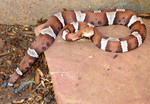|
TERMS OF USE:
This free image can only be used for non-commercial, personal
website use only. THIS IMAGE CANNOT BE
used in galleries, downloaded to your computer, posted on sites for
others to use, manipulated, downsized, or upsized. If you are confused about the
terms of use or have any questions then contact us before using the image.
Free Picture: Venomous “trans-Pecos” Copperhead Snake

|
Description
Picture of a venomous “trans-Pecos” copperhead snake, Agkistrodon contortrix pictigaster. As the southwestern-most subspecie, it is the only copperhead that ranges across the Rio Grande into Mexico (Cambell and Lamar 2004). It lives in a variety of habitats throughout the Chihuahuan Biotic Province of southwestern Texas and adjacent North-central Mexico, and is therefore, present only in the southwestern extreme of the hurricane-prone area of the United States (Gloyd and Conant, 1990), which is of importance to those who live in these regions, and first-responders offering aid to those affected by such a disaster. Its home includes riperian woodlands, forested canyons, canebrakes, and dry scrubby flatlands, preferring piles of dead cane that accumulate along rivers, which makes it particularly vulnerable to being translocated by rapidly rising flood waters (Gloyd and Connant, 1990) such as those associated with hurricane-associated floods.
A. contortrix pictigaster is patterned with 10 - 18 broad, reddish-brown to chestnut-colored cross bands that are nearly as wide at the dorsal apex as they are at the ventrolateral base. Each cross band typically bears a pale inverted U-shaped marking at each of the lateral margins. The dorsal ground color is hazel-brown with fine dark brown to dusky stippling. The cross bands extend ventrally onto the scutes, where the cranial and caudal margins, and the centers form a series of three conspicuous dark brown to black spots (triads) (Gloyd and Connant, 1990). The ventral body is characterized as ornate, and is boldly marked with dark spots and mottling. The combination of the ventral triads, and the presence of a pale inverted U-shaped marking in the ventral margin of each cross band are readily apparent features that distinguish the trans-Pecos copperhead from the “broad-banded” A. contortrix laticinctus (Gloyd and Conant, 1990).
This image was created in 2005 and provided by the Centers for Disease Control and Prevention/Edward J. Wozniak D.V.M., Ph.D.
Keywords
animal, animals, chunk head, copperhead, copperheads, pit vipers, reptile, reptiles, serpent, serpentes, snake, snakes, trans-pecos copperhead, trans-pecos copperheads, cdc, pit viper, free photography, free photo, free photos, free picture, free pictures, free image, free images
|
Similar Free snake Pictures
|
|
|
|